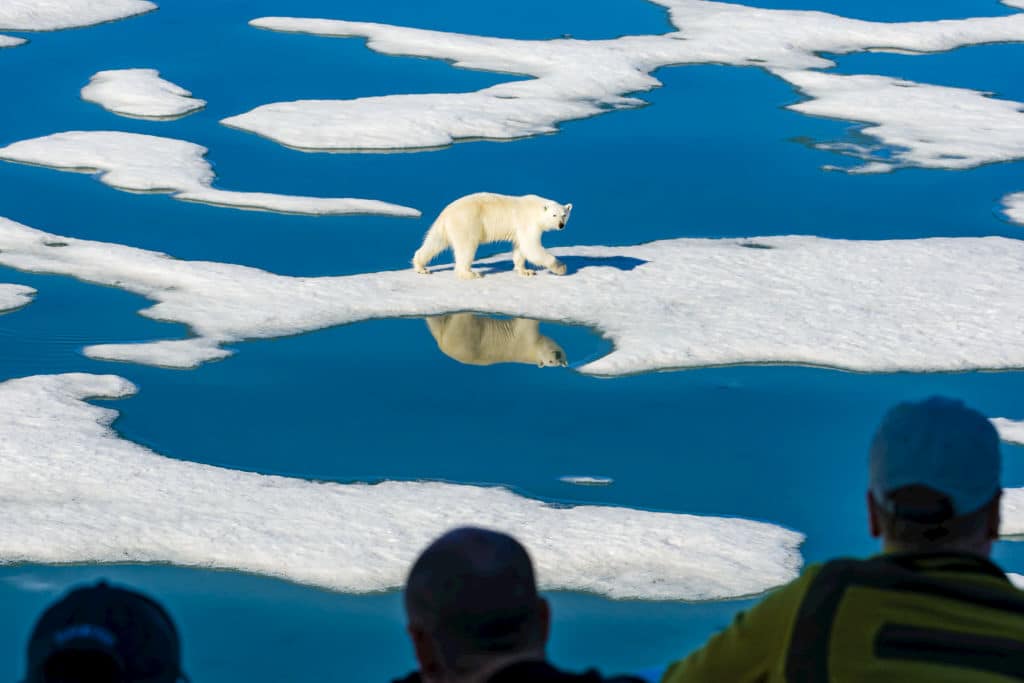What Is the Climate Crisis?
The climate crisis refers to the destabilization of the climate conditions that have allowed human communities and current ecosystems to survive and thrive on Earth. It is caused by a rise in global temperatures that scientists conclude is “unequivocally” driven by human activity — primarily the burning of fossil fuels and secondarily the destruction of forests and other natural carbon sinks. Since humans began using fossil fuels in earnest at the start of the industrial revolution, global temperatures have risen to 1.1 degrees Celsius above the 1850 to 1900 average. Global heating has now reached a rate of increase of more than 0.2 degrees Celsius per decade. This warming has already led to the melting of Arctic sea ice, the retreat of glaciers, and more frequent and intense extreme weather events like heat waves, foods and droughts. These events have already claimed lives, driven species to extinction and forced more than 13 million people from their homes in Africa and Asia in 2019 alone. With every further warming increase, the risks of additional harms become ever more severe.
Luckily, there is something we can do about it, but we have to act quickly. The latest report from the Intergovernmental Panel on Climate Change (IPCC) found that we must curb greenhouse gas emissions by 60 percent of 2019 levels by 2035 in order to limit global temperature rise to 1.5 degrees Celsius above pre-industrial levels and save hundreds of millions from suffering and poverty by 2050. Unfortunately, temperature projections based on current policies and pledges put the world on track for 2 to 3.2 degrees of warming. The climate crisis is therefore a crisis in two senses of the word. It is both “a time of intense difficulty, trouble, or danger” and “a time when a difficult or important decision must be made.” We can choose to drive our gas-powered SUVs down what UN Secretary-General António Guterres called the “highway to climate hell,” or we can turn off the ignition, take our feet off the gas pedal and walk together down a greener path.
What Are Greenhouse Gases?

Greenhouse gases get their name because they contribute to something called the greenhouse effect. When the sun’s rays penetrate the Earth’s atmosphere, these gases stop some of the heat from escaping back into space, acting like the walls of a greenhouse. Greenhouse gases already exist in the atmosphere without human intervention, and this is normally a very good thing: Without the greenhouse effect, Earth’s surface temperatures would be around 33 degrees Celsius cooler. However, human activity has released more of these gases into the atmosphere in the last two centuries, throwing the system out of balance, trapping more heat and causing global temperatures to rise.
What Are the Main Greenhouse Gases That Contribute to the Climate Crisis?
There are four main greenhouse gases causing additional warming.
Carbon Dioxide

Carbon dioxide is the greenhouse gas most responsible for heating the planet. It is a naturally occurring molecule that can be released through events like volcanic eruptions. However, since 1750, carbon dioxide concentrations in the atmosphere from the burning of fossil fuels have increased by 50 percent to reach levels not seen since around four million years ago, when sea levels were as much as 25 meters higher (approximately 82 feet) than today. In 2021, carbon dioxide reached a record 415.7 parts per million. Humans also emitted record levels of carbon dioxide over the past decade — 54 gigatonnes a year between 2012 and 2021.
Methane

Methane is a much more potent greenhouse gas than carbon dioxide — producing 28 times more warming than carbon dioxide over a 100 year period. At the same time, it lingers in the atmosphere for much shorter — around 12 years to carbon dioxide’s hundreds. The combination of methane’s potency and shorter lifespan makes reducing methane emissions a strategic priority for limiting global warming in the short term.
Methane is released both naturally — by plants decaying in wetlands — and by human activities including landfills, rice farming, the digestion of livestock animals like cows and the use of fossil fuels. Natural gas is 70 to 90 percent methane. These activities account for 50 to 65 percent of global methane emissions, and overall the gas has caused 30 percent of the post-industrial temperature hike. Indeed, the amount of methane in the atmosphere has more than doubled, reaching a record 1,908 parts per billion in 2021.
Nitrous Oxide

Nitrous oxide is a greenhouse gas primarily released by the production and use of agricultural fertilizers, though it is also emitted when fossil fuels or plant matter are burned. It is released naturally as part of the nitrogen cycle, but around 40 percent of current emissions comes from human activity. While it’s been called “a forgotten greenhouse gas” when compared to carbon dioxide and methane, it is still responsible for around 6 percent of greenhouse gas emissions. It’s also very powerful — a single molecule of nitrous oxide has 300 times the warming potential of a single molecule of carbon dioxide — and it persists in the atmosphere for around 114 years. In 2021, its atmospheric concentration reached a record 334.5 ppb, which is 124 percent of its pre-industrial levels.
Chlorofluorocarbons

Chlorofluorocarbons are the one greenhouse gas that does not occur naturally. They were created for industrial purposes and used as refrigerants, solvents and propellants for spray cans until it was discovered that they were burning a hole in the ozone layer. World leaders came together and agreed to phase out their use under the Montreal Protocol of 1987. It’s a good thing they did, because it turns out that CFCs are thousands of times more effective by mass at trapping heat than carbon dioxide. A study found that the agreement to restrict their use reduced global warming by as much as 25 percent. However, they are still occasionally emitted. A spike in 2013 was tied to illegal use in China that the nation later dealt with, but they are still released from CFC “banks” — pre-1987 insulation or cooling systems that continue to emit the chemicals.
What Are the Main Human Activities Causing the Climate Crisis?
Scientists often refer to “anthropogenic,” or human-caused, climate change. But there are really a few main human activities that are largely to blame.
Burning Fossil Fuels

The burning of fossil fuels is responsible for more than 75 percent of total greenhouse gas emissions and almost 90 percent of carbon dioxide emissions. This is because fossil fuels are made from dead and decaying lifeforms fossilized over millions of years — and carbon is the building block of life. The carbon that once helped form the DNA and proteins of ancient plants and animals is concentrated by time and pressure into coal, oil and natural gas. When these fuels are burned, that carbon once stored beneath the Earth enters the atmosphere as carbon dioxide. Leaks from fossil fuel extraction, production and transportation are also an important source of methane emissions. Many human activities currently rely on fossil fuels, from industry to heating and electricity generation to transportation. We need to find an alternative way to power these activities in order to stop overheating the atmosphere.
Land-Use Change

The second most important contribution to the climate crisis is deforestation, agriculture and other land use change, accounting for around a quarter of total greenhouse gas emissions and around 13 to 21 percent from 2010 to 2019. Trees and other plants store carbon in their trunks, leaves and roots and in the soil beneath them. When those trees are cut down or that soil is disturbed, the carbon ends up in the atmosphere and contributes to the climate crisis. What’s more, those trees and plants are no longer there to suck more carbon dioxide out of the atmosphere.
Agriculture

Tree clearing for agriculture drives more than 90 percent of tropical deforestation worldwide. In addition to getting rid of carbon sinks, the global food system emits greenhouse gases through the production and use of fertilizers and the methane-laden burps and manure of cows and other ruminants. The livestock sector as a whole is responsible for between 11.1 percent and 19.6 percent of global greenhouse gas emissions.
What Are the Main Impacts of the Climate Crisis Now and in the Future?
The climate crisis has already impacted every region on Earth. The latest IPCC report finds that both these current impacts and the risks of each increment of future warming are more severe than previously anticipated.
Hotter Temperatures

The most obvious impact of the climate crisis is an increase in temperature. Since 1970, global temperatures have increased faster than during any other 50-year period during at least the last two centuries. The last nine years are the nine warmest since record keeping began 143 years ago, and all of the 10 warmest years on record have occurred since 2010. Some scientists think 2024 might be the hottest year yet. How much temperatures continue to rise will depend on how quickly we can wean ourselves off fossil fuels. Policies in place as of 2020 put the world on track for 3.2 degrees Celsius of warming by 2100, but that could be lowered to 2 degrees Celsius if we cut greenhouse gas emissions by 35 percent by 2035 and 1.5 degrees Celsius if we cut emissions by 60 percent by the same date.
More Extreme Weather Events
The climate crisis has already led to more frequent and extreme weather events. The IPCC says it is “virtually certain” that heat waves have become more common and intense in most regions since the 1950s, with climate change the “main driver.” These heat waves have already claimed tens of thousands of lives. Most marine heat waves since at least 2006 were also likely caused by climate change, and these have doubled since the 1980s.

Because warmer air holds more moisture, the climate crisis can also lead to more extreme precipitation events, which have increased in intensity and frequency over most land areas since the 1950s. Hurricanes and other tropical storms have become wetter and more intense. Climate change has led to more or longer droughts in some regions, making the megadrought in the U.S. West 42 percent more severe. Higher temperatures and drier conditions have led to more frequent, larger and longer-lasting wildfires. If the climate continues to warm, combined heat waves and droughts and ideal wildfire conditions are expected to become more frequent. Tropical storms will continue to become more intense.
Ice Melt and Sea Level Rise

Warmer temperatures are melting ice in the world’s mountains and polar regions. The Arctic is warming nearly four times as fast as the global average, and the Greenland Ice Sheet has lost 255 gigatons of ice each year between 2008 and 2016, while Arctic sea ice has declined since 1978, with the rate of decline increasing in the last two decades and 95 percent of the oldest and thickest ice already gone. In Antarctica, ice sheets are melting at a rate of around 150 billion tons per year.
The polar ice sheets hold around two thirds of the globe’s fresh water. When they melt, that water enters the ocean, raising sea levels. To date, their melting has caused around a third of sea level rise since 1993. However, the melting of glaciers and ice sheets had driven the majority of accelerated sea level rise between 2006 and 2015. As of 2018, global sea levels had risen by 0.2 meters (approximately eight inches). In addition to polar melting, the sea level is rising because water expands as it warms. If the Greenland ice sheet were to melt entirely, it would raise sea levels by 23 feet, while the melting of all glaciers and ice sheets would raise them by more than 195 feet. While this would occur over a period of centuries, even relatively small amounts of sea level rise can threaten coastal communities with erosion, flooding, saltwater intrusion into aquifers, habitat loss and more powerful storm surges. Sea levels along the coastal U.S. are expected to rise by a foot by 2050 and two feet by 2100.
Mountain glaciers are melting as well — between 85.3 percent of Northern Hemisphere glaciers, including Greenland’s, retreated between 2000 and 2020, and nearly half of non-polar glaciers could melt by 2100 even if temperature rise is limited to 1.5 degrees. This would have devastating impacts on communities that rely on glaciers for water, power and cultural identity.
Ocean Impacts

The ocean has absorbed 90 percent of the excess heat added to the planet in the last decades, with the past 10 years being the ocean’s warmest since the 19th century. Most of this heating is occurring between zero and 700 meters (approximately 2,297 feet) from the surface. In addition to contributing to sea level rise, more intense tropical storms and the melting of sea ice, the additional heat threatens marine biodiversity through deadly marine heat waves. One of the most infamous impacts of these heat waves is coral bleaching, when warmer than average temperatures compel corals to expel the algae that give them both color and food. If temperatures rise to 2 degrees, 99 percent of tropical reefs could be lost. In general, ocean warming last century has combined with the impacts of overfishing to reduce the amount of certain fish species available for fishers.
Heat isn’t the only product of fossil fuel emissions that the ocean absorbs. It takes in around 30 percent of the carbon dioxide added to the atmosphere, leading to something called ocean acidification. Carbon dioxide dissolves in seawater into carbonic acid, which further breaks down into hydrogen ions and bicarbonate ions. Through this process, the ocean has gotten about 30 percent more acidic since the industrial revolution. When there is more hydrogen floating around in the ocean, it easily bonds with the carbonate that shell-making animals like corals and oysters need to form their shells. The decrease in carbonate is already impacting these animals, and further acidification could actually dissolve their shells. A more acidic ocean could also harm other animals like clownfish, who struggle to find their ideal habitat during their larval stage when acidity increases.
Biodiversity Loss

The ocean isn’t the only habitat where the climate crisis threatens the abundance and variety of lifeforms. The Earth is currently in the midst of a sixth mass extinction driven by human activity — losing species at a rate 1,000 times greater than any other moment in written history – and the climate crisis is an important contributor to this loss. As many as a million plant and animal species face extinction, several of them within decades.
The climate crisis is making life harder for at least 10,967 species on the IUCN Red List of Threatened Species, hastening extinction through extreme weather events, wildfires, and the spread of pests and diseases. As conditions change within a species’ range, some will be able to move into better conditions but not all will be able to relocate quickly enough. A 2020 study found that plants and animals living in areas that saw a significant increase in maximum possible temperature were more likely to be wiped out locally. By 2070, 30 to 55 percent of those species could become entirely extinct depending on how successful we are at controlling emissions.

Food and Freshwater Scarcity
All of these changes to natural processes and ecosystems will not leave human society unaffected. Already, the climate crisis is increasing both food and water insecurity through drought, ocean warming and acidification and the loss of sea ice that Indigenous Arctic communities rely on for hunting. Partly because of climate change, around half of the world’s population endures “severe water scarcity” for at least some of the year.

All of this will only get worse. Around 22 percent of the world’s population relies on glaciers for their primary source of drinking water, and future melting could deprive them of this essential resource. Saltwater intrusion from sea level rise also threatens to inundate the freshwater supply of people living on low-lying atolls. As crop yields decrease as temperatures rise, this could push 43 million people below the poverty line by 2030 just in Africa.
Poverty, Conflict and Displacement

A decrease in water and food resources will inevitably push populations into poverty, exacerbate conflicts between them and force people from their homes in search of a better life. As the climate warms, its impacts will interact more often with other factors like resource competition or political tension to exacerbate conflict. For example, while the civil war in Syria cannot be blamed on climate change alone, there is evidence that it was inflamed by the worst multi-year drought the country had seen in 900 years.
The war sparked a refugee crisis, with 5.5 million Syrians now living in other countries after fleeing the violence. Between 2010 and 2019, extreme weather events directly displaced around 23.1 million people each year. A recent Somalia-based study found that a 50 millimeter reduction in monthly rainfall could increase displacement by a factor of two, and a monthly temperature rise of 1 degree Celsius could increase displacement by a factor of 10. Depending on how much is done to curb emissions, one billion people could be climate refugees by 2050.
Human Health
The Lancet’s 2022 report on climate change and health concluded that human health was already “at the mercy of fossil fuels.” The number of heat-related deaths for people older than 65 increased by around 68 percent from 2000 to 2004 and from 2017 to 2021. Extreme weather events expose people to health hazards like increased wildfire smoke and infectious diseases that spread when drought puts sanitation at risk. Heat waves and other extreme weather events can have a negative impact on mental health, not to mention the growing issue of climate anxiety.

The range of disease-carrying organisms is already expanding as temperatures warm. For example, between 2012 and 2021, the ideal climate for the transmission of dengue by the Aedes aegypti and Aedes albopictus mosquitoes increased by 11.5 percent and 12 percent respectively. In the future, even more climate change could interact with other factors like urbanization to increase the risk of future pandemics.
Who Is Most Responsible?
All of humanity is not equally responsible for the climate crisis. Certain nations, companies and individuals have emitted significantly more greenhouse gases than others.
Countries

Historically, the U.S. is the country that has emitted the most climate-warming emissions, contributing around 20 percent to the total between 1850 and 2021. It is followed by China at 11 percent, Russia at 7 percent, Brazil at 5 percent and Indonesia at 4 percent. The culpability of the latter two is largely because of deforestation. Former colonial and industrial powers Germany and the UK contributed 4 and 3 percent respectively, but this doesn’t include emissions from their overseas colonies. A different set of calculations found that the UK and EU were together responsible for 22 percent of emissions between 1751 and 2017, while the U.S. was responsible for a quarter.
Today, China emits the most of any nation followed by the U.S., India, the EU, Russia, Japan, Brazil, Indonesia, Iran and Canada. Together, these countries are responsible for more than two-thirds of global emissions, and the top three are responsible for 42.6 percent. In comparison, the 100 least-emitting countries only contribute a modest 2.9 percent.

Companies
Certain companies — especially fossil fuel and meat and dairy companies — contribute disproportionately to the climate crisis because their business models are bound up with either burning oil, gas or coal or clearing biodiversity for agriculture. Only 100 fossil fuel companies — including ExxonMobil, Shell, BP and Chevron — have contributed 71 percent of global emissions since 1988, one study found. Not to be left out, the top five meat and dairy companies in the world have a carbon footprint equal to Exxon’s.

But the fossil fuel industry’s responsibility extends beyond its product. In recent years, evidence has emerged that most if not all of the major oil and gas companies were aware of the dangers posed by their actions in the 1970s and 80s but instead chose to fund climate denial and lobby politicians against shifting to renewable energy. Based on both their emissions and their political actions, a recent study calculated that the 21 largest fossil fuel companies owe the world at least $5.4 trillion in reparations.
Individuals
For the most part, individuals are not the driving force behind climate change. Even if you drive a gas-powered car an hour and back to work each day or heat your home with electricity from a coal-powered plant, your choices are largely shaped by the economic pressures and energy and transportation infrastructure that scaffolds your life. However, there is an exception: uber-wealthy individuals who ride in private jets and invest in polluting industries.
A 2022 study found that the wealthiest 10 percent of people on Earth were responsible for almost half of global emissions. While there is a large gap between the emissions of individuals in wealthier and poorer countries, there is now a greater gap between the emissions of wealthy and poorer individuals within the same country. The poorest 50 percent of the U.S population, for example, is actually emitting at close to the nation’s 2030 per capita emissions goal, while the richest 10 percent would need to slash their emissions by 86 percent to meet it.
Why Is the Climate Crisis a Social Justice Issue?
The disparity in responsibility for the climate crisis is why the IPCC emphasized climate justice in its most recent report. “Climate justice is crucial because those who have contributed least to climate change are being disproportionately affected,” report author Dr. Aditi Mukherji said in a statement upon its release. “Almost half of the world’s population lives in regions that are highly vulnerable to climate change. In the last decade, deaths from floods, droughts and storms were 15 times higher in highly vulnerable regions.”

What’s more, the climate crisis can exacerbate existing inequalities, making life harder for racial minorities trapped by historic redlining in urban heat islands, women in agriculture who already face pay discrimination before having to contend with climate shocks or low-income people in previously colonized countries who must now endure drought or severe storms. Responding urgently and equitably to the climate crisis is therefore essential from a social justice perspective, both to avoid the widening of existing gaps and to take the opportunity to close them as we reimagine society along more sustainable lines.
What Has Been Done About It So Far?
The international community has been talking about taking action on climate change since 1992, when the United Nations Framework Convention on Climate Change (UNFCCC) was adopted. Since then, world leaders have held 27 conferences of the parties to this convention, or COPs, at which they have made varying degrees of progress. Perhaps the most significant COP was COP 21, which met in Paris in 2015. It was here that nations negotiated the Paris Agreement to keep warming to “well below” 2 degrees Celsius above pre-industrial levels, and ideally limit it to 1.5 degrees. Nations were supposed to submit voluntary nationally determined contributions (NDC) every five years to say how much they would reduce emissions, with the end goal of reaching net zero emissions by 2050.
To date, the world is not on track to honor the Paris Agreement. For one thing, there is an “implementation gap” as current policies lag behind countries’ NDCs. Policies in place as of 2020 would put the world on track for 3.2 degrees Celsius of warming, while aligning policies with pre-COP26 NDCs through 2030 would limit it to around 2.8 degrees. Since COP26, nations have come forward with more ambitious pledges and net-zero promises. Accounting for these pledges could lower warming to 2.4 to 2.6 degrees Celsius. By considering longer term or net-zero pledges, Climate Action Tracker saw a possibility for 2 degrees of warming, and an even more optimistic 1.8 degrees when including net zero promises in effect or in discussion from around 140 countries.
While existing actions and policies are not sufficient, they have already made a difference. Policies to improve energy efficiency, halt deforestation or develop renewable energy sources have likely prevented several gigatons of carbon dioxide a year from entering the atmosphere. Progress already made has rendered the worst-case emissions scenario, which assumed a 500 percent increase in coal use and projected a 6-degree-Celsius temperature rise by 2100, “exceedingly unlikely.” That said, a 3-degree warmer world would still mean the near eradication of both coral reefs and Arctic sea ice and more days in which heat and humidity would reach dangerous levels for human survival. And the latest IPCC assessment cycle found that the temperature threshold for various risks — such as extreme weather events or threatened systems — was lower than previously estimated. Honoring the Paris Agreement goal is more urgent than ever.
What Still Needs to Be Done?
Climate action falls into two broad categories: mitigation and adaptation. Mitigation means actively reducing the amount of greenhouse gases in the atmosphere to stabilize global temperatures, while adaptation means adjusting to the changes in sea level or weather patterns that are already locked in.
Mitigation
The most important thing that can be done to stave off additional climate change is to stop burning fossil fuels as soon as possible. This means both not developing any new fossil fuel projects and even ceasing to exploit the deposits that already exist. The IPCC found that emissions from already existing fossil fuel infrastructure would gobble up the remaining carbon budget for limiting warming to 1.5 degrees Celsius, unless those emissions were somehow offset or removed from the atmosphere with still-unreliable carbon capture technology.
In order to have a 50 percent shot at the 1.5 target, greenhouse gas emissions must fall by 60 percent by 2035. This can be achieved by shifting rapidly to renewable sources of energy like wind and solar, replacing gas-fueled cars and trucks with electric vehicles and improved public transit, designing more sustainable cities, boosting the energy efficiency of buildings, decarbonizing industry, making agriculture more sustainable, protecting and restoring natural carbon sinks like forests and actively removing carbon dioxide from the atmosphere through carbon capture and storage.
Adaptation
Human activity has warmed the atmosphere enough that some climate impacts are already occurring and likely to continue. However, we can change how we design communities and infrastructure to make them more resilient to these changes. For example, the Billion Oyster Project in New York is restoring the city’s oyster reefs in part to protect it against storm surges and sea level rise, while the government of California is learning from the once-banned Indigenous practice of controlled burns to prevent larger fires. Farmers on the coast of Vietnam have begun keeping bees to help with mangrove restoration instead of gathering dwindling snails and crabs, while El Salvador is protecting itself from floods and landslides by restoring its surrounding forests.
When it comes to adaptation, there is still more work to be done. The 2022 UN Adaptation Gap report found that 84 percent of countries participating in the UN Framework Convention on Climate Change had some kind of adaptation plan, up 5 percent from the year before. However, funding for adaptation in the Global South is five to 10 times less than it needs to be, and the gap is widening instead of shrinking.
Political and Social Change
The climate crisis isn’t merely a technological problem caused by how we power our daily lives. It’s a political problem caused by an economic and political system that often prioritizes the short-term profits of large corporations over the long-term well-being of communities and ecosystems and considers nature as “resources” to be exploited for economic gain.
Therefore, solving the climate crisis means making fundamental changes to the way we write our laws and structure our society. This could include things like giving rights to nature, so that communities have a legal recourse to protect forests from destruction or waterways from pollution, or ideas like degrowth and doughnut economics that seek to reorganize the economy around meeting everyone’s essential needs without overtaxing our planetary support system. Many activists are calling for ideas like a Green New Deal or a just transition that would use mitigating and adapting to the climate crisis as an opportunity to address and resolve long-standing inequalities and make sure that when we transition to a new form of energy, no one is left behind.

Takeaway
The climate crisis may be the single greatest challenge humans have faced as a species. Every day seems to bring a new unprecedented weather event or another study warning about unsustainable emissions use or unavoidable climate impacts. But that doesn’t mean we should give up hope. While not everyone is equally to blame for climate change, everyone can play a role in the solution, from reducing one’s carbon footprint to experimenting with alternative, more sustainable forms of community to participating in climate activism to put pressure on world leaders or fossil fuel executives. The good news is that many climate solutions — from clean energy to urban trees — would make the world healthier, greener, more just and all around more pleasant to live in. Change is inevitable, but if we come together to stop burning fossil fuels and adapt in a way that prioritizes the most vulnerable among us, there’s still a chance that it can be change for the better.

The post Climate Crisis 101: Everything You Need to Know appeared first on EcoWatch.
https://www.ecowatch.com/climate-crisis-facts-ecowatch.html
Green Living
8 Best Non Toxic Rugs For a Sustainable Home
Last Updated on November 6, 2025
Did you know most rugs are made from polyester, aka plastic? Arguably, a good chunk of our furniture and home decor is nowadays.
And lets not forget – rugs can get a lot of foot traffic. If it’s made from polyester, chances are those plastic fibers are going to shed and get onto us. Or worse, in us.

Some of the links in this post are affiliate links; for more information please see my disclosure policy.
Microplastics have been found in human feces, blood, and even placentas. And according to a study from Stanford University, those who had microplastics in their plaque had a higher risk of heart attack, stroke and death than those who didn’t.
On top of this, 5 billion pounds of rugs go to waste each year – that’s 2% of total US landfill. And if they’re made from plastic? They won’t biodegrade.
It’s more important than ever to reduce our exposure to microfibers where we can. Which is why I’ve rounded up the best non toxic rugs on the market.
what is the least toxic rug?
The least toxic rug will have sustainable materials and use no harsh chemicals (like PFAs) in their production.
Here’s what to look for when purchasing a non-toxic rug:
- Sustainable materials, such as organic cotton, jute, sisal or wool
- Low-waste packaging + delivery
- Natural, non-synthetic dyes
- Third-party certifications like OEKO-TEK, Fair Trade, GOTs
- Easy to spot-clean or machine wash
- Available in various styles, patterns + colors to suit your needs
do all rugs have PFAS?
According to Department of Toxic Substances Control (DTSC), only four samples of 201 carpets and rugs were found to contain more than 100 parts per million in their fibers, indicating PFAS were intentionally added to the products.
However, while PFAs may not be a huge concern for rugs, microplastic pollution is, specifically if your carpet is synthetic. Your best bet is to check the material your rug is made from and choose natural fibers whenever possible.
what is the best non-toxic rug for nursery?
The best non-toxic rug for a nursery would be made from natural materials like wool and organic cotton (which are soft on baby’s skin).
I recommend also checking for natural latex for the rug backing and underlay pads. Brands on this list that offer kid-friendly sizes and patterns include Lorena Canals, Nestig, Quince, and Loomy (more on each below).
what brand of rugs are non-toxic?
The brands of rugs that are non-toxic are listed below. I’ve gone ahead and highlighted some of my favorite features of each brand, but it isn’t an exhaustive list. Be sure to check out their websites for more information.

1. hook and loom
- Various rug sizes, shapes + patterns
- Made from GOTs certified organic cotton, recycled cotton + wool
- No dyes or harmful chemicals
- No latex

2. lorena canals
- Various rug sizes, shapes + patterns
- Handmade by artisans using recycled materials like organic cotton + wool
- Nontoxic dyes
- Make your own option
- Machine washable
- Rugcycled line made from recycled materials in their own factory

3. sabai
- Field rug
- Woven using wool + jute
- Available in 3 varying sizes
- Rug pad add-on available for reduced movement
- Certified B Corporation

4. quince
- Various sizes + patterns, best known for vintage-inspired looks
- Made from natural materials like wool, jute, + cotton
- Handcrafted by artisans in India
- Transparent pricing practices
- Compostable poly bags + recycled plastic mailers

5. west elm
- Rugs for every area of the home, in varying sizes
- Made from wool, jute, hemp, cotton, TENCEL + recycled materials
- Handspun by skilled artisans in India

6. nestig
- Area + washable rugs made with fun shapes/designs for babies + kids
- Washable rugs made with organic cotton + nontoxic dyes
- Area rugs made with cotton + each colored element crafted from recycled cotton
- Handmade in Brazil

7. cold picnic
- Various rug shapes + sizes, abstract patterns + bold colors
- Made with wool, bamboo silk, cotton, hemp, + deadstock materials
- Designed in a Brooklyn studio, handmade by artisans in India
- Committed to reducing packaging waste where possible

8. loomy
- Various rug sizes, shapes + patterns
- Made from banana silk, hemp, jute, recycled fiber, viscose, or wool
- Any colored yarn dyed using low-impact techniques
- Handcrafted by indigenous artisans
So what do you think of these non toxic, sustainable rugs? Let me know in the comments!
The post 8 Best Non Toxic Rugs For a Sustainable Home appeared first on Going Zero Waste.
Green Living
Our Picks for the Top Black Friday and Cyber Week Sales From Sustainable Brands
It’s not easy shopping consciously during the holiday season — especially during Cyber Week. It’s a time of year notorious for overconsumption, impulse buys, and purchases that are bound for the landfill just months (or even days) later.
But I also don’t believe that sustainable living just looks ONE way. These sustainable and ethical Black Friday discounts can be a way to access better products for more affordable prices. And a great way to support small businesses over big box stores during what is often the most important time for businesses.
Here are some things to keep in mind to engage with Cyber Week and Black Friday more sustainably!
1. A “deal” isn’t a “deal” if we’re buying things we won’t actually use and enjoy long-term (it’s easy to get caught up in the thrill of a deal and buy something that we totally wouldn’t have bought otherwise — been there, done that!)
2. Our whole platform is about challenging overconsumption, but if we want to intentionally purchase some ethical clothing or eco-friendly gifts, these sale days can be a great opportunity to support conscious brands more affordably.
3. It’s worth asking some additional questions and taking some extra time to make these purchasing decisions because the dopamine hit of a good deal can skew our decision-making abilities!
4. If the whole Cyber Week affair stresses you out or you’re feeling pressured to buy more than you originally intended, know that you can step out at any time. Turn off your notifications and get outside and/or spend time with loved ones! You do not need to buy ALL (or any) of your holiday gifts during this week.
But if you’re ready to make a mindful investment in something for yourself, or have a long list of gifts and you want some support in shopping small and consciously, check out this list of the best sustainable and ethical Black Friday and Cyber Week deals going on. Plus, we featured some companies opting out of deals and doing donations instead.
Transparency note: we only feature brands that meet high standards for sustainability we love, that we think you’ll love too. Some of these links are affiliate links, meaning if you purchase via these links we may earn a commission, which helps us continue this site. Thanks for your support!
Here Are Our Top Picks for This Season:
1. Passion Lilie
With elevated womenswear and menswear that pop in prints and weaves, this woman-owned brand champions artisanal techniques like hand block printing and hand weaving to create the most flattering styles that’ll withstand trends.
The brand carefully creates its pieces to make sure they are biodegradable at the end of their lifecycle by using natural fibers like recycled cotton and organic cotton that are treated with organic dyes. Since artisanal craft plays such an important role in their design ethos, Passion Lilie ensures all producer groups they employ are either Fair Trade certified or employ its core practices.
Sale Details: 30% off site-wide with free shipping over $125. Use coupon code BFCM2025. Valid November 26 – December 3
2. Mightly
Founded by four mothers who wanted to create comfortable, long-lasting clothing for active children – minus the toxic chemicals – Mightly is setting the standard for consciously crafted kidswear that takes fun designs just as seriously. Don’t just take our word for it, scroll their site to find Mightly’s delightfully colorful collection of clothing for babies, toddlers, and kids in prints that’ll add a spring in your little one’s step.
Every piece is made using Global Organic Textile Standard certified organic cotton and is sewn at Fair Trade certified factories, ensuring every step of production is responsible.
Sale Details: Tiered discount available sitewide November 25 – December 1.
- 15% off orders of $75+
- 20% off orders of $150+
- 30% off orders of $250+
3. MasayaCo
If you’re seeking artisanal furniture that’ll breathe some character into any space, then look no further. MasayaCo creates a range of handcrafted pieces from reforested teak wood that supports artisans and has an enduring quality. You’ll find versatile pieces to suit nearly every room of your home — and even something for outdoor settings that’ll withstand the elements owing to their naturally water-resistant teak.
MasayaCo has built a restorative model where they grow and manage their own forests, harvesting mature trees for furniture while 30-40% of the reforested land is preserved as a native forest.
Sale Details: 20% off all items and up to 40% off on select items November 19 – December 4. All discounts auto-applied at checkout.
4. Medley
For those who prefer plush, elevated furniture with an inviting appeal, Medley will make you feel right at home with their pieces. Ready to insert a mid-century modern touch into any home, they use time-honored building techniques to offer lasting furniture that ages beautifully.
You can lounge easy on Medley’s pieces knowing that right from the filling to the upholstery, and wood, the materials they use are tested by certifying bodies like OEKO-TEX® STANDARD 100, CertiPUR-US®, and GREENGUARD Gold, to name a few, which indicate the materials have been tested to be free of harmful substances and meet the most stringent standards for low chemical emissions.
Sale Details: TBA | November 28 – December 2
5. Sabai
Nothing adds life to a living room quite like a cozy and inviting sofa. And at Sabai, you’re bound to find a cushy one that’ll serve itself as a centerpiece for the heart of your home. Sabai is on a mission to make sustainable furniture that’s affordable, repairable, and circular.
The company has a range of sofas and loveseats made from recycled and upcycled materials in non-toxic finishes that are completely modular, so they can accommodate and adapt to your changing needs. All of their pieces are created on a made-to-order basis with the option to order up to six swatches free of charge for the discerning decorators.
Sale Details: TBA
The following Black Friday and Cyber Week sales from sustainable brands are sorted by category!
Sustainable Homewares & Furniture Sales
Avocado
Non-toxic brand with low-waste manufacturing offering your bedroom a sustainable upheaval with organic mattresses and bedding
Discount: TBA
Urban Natural
Sustainable home decor and furniture retailer with top brands like Copeland, Cisco Home and East Fork
Discount: TBA
Boll & Branch
Fair trade and organic-certified bedding and bath products
Discount: TBA
The Citizenry
Artisan-made home goods and furniture
Discount: TBA
Coyuchi
Sustainable bedding, bath, home goods, and pajamas made with GOTS-certified organic cotton or regeneratively-sourced fibers
Discount: TBA
My Green Mattress
Non-toxic organic mattresses, bed frames, and accessories
Discount: TBA
Saatva
Eco-friendly memory foam mattresses and organic bedding
Discount: TBA
Savvy Rest
Organic mattress and non-toxic furniture retailer using sustainable natural materials
Discount: TBA
SOL Organics
GOTS-certified organic cotton bedding
Discount: TBA
Ethical & Sustainable Fashion Holiday Sales
Christy Dawn
Slow fashion brand with dreamy dresses and other clothing made responsibly from deadstock fabric, organic cotton, or regenerative cotton grown by Oshadi in India
Discount: TBA
Kotn
Responsible clothing brand offering everyday essentials made from natural fibers with a traceable origin
Discount: TBA
Mate The Label
Loungewear and basics made with non-toxic and organic materials
Discount: TBA
Monica Vinader
Jewelry made from 100% recycled gold vermeil and 100% recycled sterling silver
Discount: TBA
Organic Basics
Eco fashion brand with intimates, basics, activewear and lounge apparel made with earth-minded fabrics
Discount: TBA
PACT
Organic cotton basics and loungewear plus home textiles made in Fair Trade Certified factories
Discount: TBA
Tradlands
Nap dresses, balloon pants, and all things cozy, crafted in sumptuous natural fibers and deadstock materials
Discount: TBA
The RealReal
Luxury fashion consignment site for finding pre-loved designer apparel and accessories
Discount: TBA
The Knotty Ones
Timeless and stylish hand-knitted knitwear made with biodegradable yarns crafted by female artisans living in rural Lithuania.
Discount: TBA
Thesus
Ethical footwear brand with vegan boots and sneakers made from sustainable, traceable materials, including large percentage of recycled materials
Discount: TBA
Vestiaire Collective
Luxury fashion resale site
Discount: TBA
tentree
Eco-minded clothing and accessories brand that plants 10 trees with every order
Discount: TBA
ThredUp
Online secondhand marketplace
Discount: TBA
Subset
Organic cotton underwear and bralettes
Discount: TBA
Brook There
Comfy organic cotton undergarments: underwear, bralettes, and nightgowns cut and sewn in the U.S.
Discount: TBA
EILEEN FISHER
Timeless, high quality slow fashion brand with circularity programs
Discount: TBA
HYER GOODS
Wallets, bags, and other accessories made from upcycled materials
Discount: TBA
Whimsy + Row
Eco-friendly Los Angeles-based clothing label with effortless pieces
Discount: TBA
Toad&Co
Eco-friendly men’s and women’s outerwear and casual clothing
Discount: TBA
Reformation
Sustainably-minded apparel brand actively working towards 100% circularity and building a Climate Positive business
Discount: TBA
Clean and Low Waste Beauty
100% Pure
Fruit-pigmented makeup and plant-based non-toxic skincare
Discount: TBA
Activist Skincare
Woman-owned brand creating high-performing vegan skincare that comes in plastic-free and refillable packaging
Discount: TBA
ILIA
Clean makeup brand — personally I love their Limitless Lash and Super Serum Skin Tint
Discount: TBA
Detox Market
Clean beauty and wellness retailer
Discounts: TBA
Henry Rose
Fine fragrances with 100% ingredient transparency; EWG Verified and Cradle to Cradle Certified
Discount: TBA
Kjaer Weis
Natural makeup brand with low-waste refillable packaging
Discount: TBA
Sustainable Cookware, Cleaning & Daily Essentials
360 Cookware
Non-toxic stainless steel cookware crafted in Wisconsin in the U.S.
Discount: TBA
Blueland
Eco-friendly cleaning supplies, including dish soap and laundry detergent
Discount: TBA
Our Place
Non-toxic non-stick pans made in ethical factories; WOC-owned
Discount: TBA
Enviroscent
Non-toxic, cruelty-free refillable home scents
Discount: TBA
XTREMA
Non-toxic ceramic cookware
Discount: TBA
Dropps
Biodegradable laundry and dishwashing pods
Discount: TBA
We’re continuing to update this post so be sure to bookmark it for later!
In the meantime, check out our gift guide: 30 Sustainable and Ethical Gift Ideas for Everyone On Your List
The post Our Picks for the Top Black Friday and Cyber Week Sales From Sustainable Brands appeared first on .
Our Picks for the Top Black Friday and Cyber Week Sales From Sustainable Brands
Green Living
21 Eco-Friendly & Ethical Gift Ideas For Everyone on Your List
From gorgeous home decor and indulgent organic beauty to artisanal quality accessories and thoughtfully-crafted gift sets, you’re sure to have a successful (and stress-free) gift-giving experience for everyone on your list through our curation of conscious yet covetable ethical gifts.
We know that finding that perfect present for every individual in your life can be an overwhelming task, especially if you’re a conscious-minded shopper. To put you out of your holiday-gifting-induced anxiety, we’ve put together a comprehensive, sure-fire assortment of ethical gift ideas for you.
So, go ahead and secure your favorite spot on the couch to get ready to check off your gift giving list, because this ethical gift guide will not disappoint. With something for every special someone on your list — even the hard-to-shop-for folks in your life — we’re making it possible to get much of your seasonal shopping accomplished in one place.
Rest assured, you’ll find something delightful for yourself too — maybe a set of gram-worthy pastel cookware? Think of it as an incentive to get you through the holiday hustle.
Now, don’t let us keep you…get ready to have your gift-wrapped ducks in a row with our sustainable gift ideas ahead. The perfect gifts for socially conscious and environmentally aware loved ones in your life!
Please note that this guide includes CL&S partners and affiliate links. As always, brands meet strict criteria for sustainability and are brands we love — and that we think you’ll love too!
1. Organic Cotton Clothing by Passion Lilie
Why we love it: Fair Trade, Organic Cotton, Pays Living Wages, Woman-Owned | Price: $68+
Passion Lilie offers a range of elevated clothing made from sumptuous organic cotton fabric that’ll keep your loved ones looking stylish and feel all snuggled up come winter. From handwoven shirts for men to figure-flattering hand-printed dresses for women, the brand’s dedication to highlighting artisanal craft reverberates throughout its collection. We recommend bookmarking their crimson hand-printed snowflake dress for the women who’ll appreciate a holiday-themed gift. You could also complement the dress with a dainty little stocking stuffer like one of the tea towels or napkins from their collection of kitchen linens in bright and charming prints.
2. Handcrafted Teak Furniture by MasayaCo
Why we love it: Reforested Teak Wood, FSC® Certified, Vertically-Integrated Supply Chain, Reforestation Program | Price: $55+
Offering artisanal teak furniture that’ll add a touch of understated elegance to any home, Masaya & Co. has curated a range of side tables and stools under $350 for the discerning decor enthusiasts. Handcrafted from durable and naturally water-resistant teak wood, their slatted top Japanese-inspired Zapatera stool has garnered raving reviews about just how well it holds up as an in-shower stool. The brand operates on a self-sustaining model by growing its own FSC® Certified teak trees on reforested land in Nicaragua.
3. Organic Cotton Kidswear by Mightly
Why we love it: GOTS Certified, Fair Trade Certified , Woman-Owned | Price: $18+
, Woman-Owned | Price: $18+
For the little ones you know and adore, Mightly has a range of organic cotton kidswear that’ll make for a great gift this festive season. Think dresses that are big on twirl factor, cozy pajamas with prints that pop, and unisex hoodies with snap front pockets to store all their tiny treasures. Every piece is made with GOTS certified organic cotton, which explicitly prohibits the use of toxic chemicals in the finished product, making it ideal for kids with sensitive skin. And if that wasn’t reassuring enough, the pieces are also thoughtfully designed to include details like tag-free labels, easy-to-wear fits, and playful designs that make it fun yet functional.
4. Non-Toxic Loungewear by MATE the Label
Why we love it: Plant-Based Materials, B Corp, Woman-Owned, GOTS Certified Fabrics | Price: $48+
With laidback loungewear that strikes the perfect balance between fashionable and effortless, MATE the Label boasts of cozy threads you’d want in your wardrobe come winter. Stylish options are just a bonus, the brand is committed to keeping its clothes free of toxic chemicals and harmful dyes while adhering to self-imposed protocols to ensure the factories it works with are safe, fair, and compliant with California labor laws. They’ve also made choosing a gift a lot easier with their curated holiday guide that’s categorized by budget and persona.
5. Refillable Hand Soaps by Blueland
Why we love it: WOC-owned, Plastic-free, Refillable, Natural Ingredients | Price: $12+
A conscious gift that is both practical and plastic-free, Blueland has floral-scented hand soap tablet refills can be paired with their glass dispenser bottle that’ll stay in use on the bathroom countertop for a long time. The process of using these is as easy as filling up the bottle with warm water, dropping in a soap tablet, and pumping it to find hydrating, foamy goodness at your fingertips.
Blueland’s Garden Blooms Variety Pack soap tablets feature plant-based and planet-friendly ingredients in scents inspired by the fragrances found in your own backyard.
6. Premium Loose Leaf Tea Collection by Rishi Tea & Botanicals
Why we love it: USDA Certified Organic, Ethically Sourced, Agrochemical-free | Price: $67
For the ones who cherish daily indulgences like a warm cup of tea, this gift set will send them on a sensory journey through global tea traditions. This gift set features 12 curated blends that range from delicate green teas to robust black teas, refreshing herbals, and fragrant oolongs. Don’t just take our word for it, one reviewer claims the set was “very luxurious” and found the tea selection to be “amazing and delicious”. The brand supports growers through ethical and direct sourcing that pays 5-10x the commodity prices to incentivize their efforts on sustainable harvests of organic quality.
7. Bonfire Reusable Candle by Mimi & August
Why we love it: Reusable, Soy Wax, Non-toxic Fragrance | Price: $38 CAD
Hunting for the perfect holiday gift to present a great hostess? Snatch up this fragrant little candle to light up their space with an inviting aroma.
Evoking the smell of a nostalgic campfire with notes of cedar, vanilla, and smoke, this hand-poured soy wax candle comes in reusable cups of different sizes that can be filled with some hot cocoa and marshmallows once used up.
8. Jewel Tone Birth Month Dish on Uncommon Goods
Why we love it: Certified B Corporation, Philanthropic, Reforestation Program, Pays Fair Wages | Price: $25
Glazed in birthstone colors, this jewelry dish is the prettiest little ethical gift that’ll adorn any dressing table. They feature crackled glass centers resembling crystalline geode slices that give them a distinctive appearance. Simply select the birth month to get a unique jewelry dish that’s just as special as the person you intend to give it to.
Crafted by a trained female potter, you can find more such unique handmade gifts on Uncommon Goods where independent designers are celebrated for their work.
9. Sake Body Lotion by cocokind
Why we love it: WOC-owned, Certified Organic Ingredients, Philanthropic, Life Cycle Transparency | Price: $23
Crafted with Japanese fermented rice wine that’s rich in smoothing enzymes and microbiome-friendly prebiotic sugars, the sake body lotion by cocokind has a reviewer describing it as “the only body moisturizer” where they’ve “used the entire bottle.”
Available in an upcycled plastic bottle that’s fully recyclable, the sake extract they use is created by fermenting rice kernels and is completely alcohol-free. It also contains a blend of sunflower seed oil and shea butter that’ll leave skin feeling supple and soft.
10. Organic Towels by COYUCHI
Why we love it: Plant-Based Materials, Fair Trade Certified Factories, GOTS Certified Fabrics | Price: $18+
Factories, GOTS Certified Fabrics | Price: $18+
Know someone who loves a good towel lounge after a shower? We reckon these indulgent organic towels might just motivate them to stretch those sessions even further. Offering an array of matching organic cotton towel sets in weaves and textures that look like they’ll wrap you up in luxury, these towels also come in lovely earthy tones and size options, in case you aren’t keen on getting the entire bundle. They’ve even got a set of plush cotton robes that’ll offer them enough reason to not leave the house and disappear into it like a second skin.
11. Handcrafted Wool Slippers by Kyrgies
Why we love it: OEKO-TEX® STANDARD 100 Certified, Biodegradable, Plastic-Free, Low-Waste Practices, Woman-Led Factories | Price: $89+
Let your loved ones kick up their feet in comfort come winter with a little help from Kyrgies wool slippers. Kyrgies’ cozy slip-on offerings are handcrafted in Kyrgyzstan, where local sheep are known for producing wool with long fibers that are ideal for felting in a mulesing-free process. The wool is felted by a women-led factory using centuries-old techniques, ensuring leftover off-cuts are reused as extra padding in their slippers or repurposed as natural insulation for buildings.
12. Weighted Blanket by Bearaby
Why we love it: OEKO-TEX® Standard 100 Certified, Global Recycled Standard Certified, GOTS Certified, Reforestation Program | Price: $199+
For the busy bees who could use some serious R&R, this weighted blanket will help them hit the hay faster. Known for aiding with naturally deeper sleep cycles, Bearaby’s weighted blankets are crafted using organic cotton that’s free of fillers and owes its weight to the chunky knit fabric alone.
Not just for cozy winters, these machine-washable cotton blankets are knitted for maximum breathability making them perfect for all seasons.
13. Life Designer Journal by Intelligent Change
Why we love it: Philanthropic, Natural Materials, Recycled, Compostable, FSC® Certified Paper | Price: $39
For the ones who have a special spot for aesthetic stationery, this journal is a gift they won’t judge solely by its pretty cover.
Filled with mindful prompts centered around five essential pillars that guide you through a self-reflective journey to help manifest your best self, this journal will be a portable therapist and best friend bound between the pages that might just have you picking up a copy for yourself as well.
14. Tree of Life Cork Yoga Mat by Scoria
Why we love it: Woman-owned, Natural Materials, Philanthropic | Price: $105
Offering the ultimate incentive for perfecting the warrior two pose, this alignment cork yoga mat features a methodical tree of life print that isn’t just aesthetically appealing but also helps properly align postures with a line across the middle. Talk about combining style and function!
Crafted with a sustainably harvested cork surface that’s backed by natural rubber, this anti-slip mat comes with a handy cotton mat carry strap.
15. Shallow Dinner Set by East Fork
Why we love it: Certified B Corporation, Philanthropic, Pay Living Wages | Price: $156
For the friend who is always posting perfectly plated stories of what they’ve cooked, this set will be a highly welcome addition to their dinnerware collection.
Including two bowls and three plates in different sizes, this handcrafted ceramic shallow dinner set comes in many hues, but we highly recommend the black set for its understated elegance and the way it’ll make a rainbow salad or smoothie bowl pop.
East Fork’s pottery glazes are completely food-safe and free of lead so they won’t have to worry about heavy metals leaching into meals.
16. Safe & Snuggly Baby Box by The Filtery
Why we love it: Woman-Owned, Non-Toxic, Plastic-Free | Price: $125
For the mindful new parent who’d appreciate a practical gift for their little one, this box is a thoughtful curation of non-toxic baby essentials like an organic diaper balm, plastic-free feeding bottle, organic cotton blanket with pacifier, silicone bath toys, and fragrance-free body wash, along with a wonderful plantable holiday card that’ll sprout up like their child.
The best part? It’ll arrive in a ready-to-gift box that won’t require any additional gift-wrapping with the option to add a personalized note at checkout that’ll be hand-written for the recipient.
Use code CONSCIOUSSTYLE at checkout for 10% off!
17. Sock Gift Boxes that Give Back by Conscious Step
Why we love it: GOTS Certified, Fair Trade Certified , Philanthropic | Price: $35+
, Philanthropic | Price: $35+
Colorful socks with fun designs that don’t just look good but also give back, these ethical gift sets will easily be one of the most meaningful presents you’ll give your loved ones. These soft organic cotton sock sets are created in collaboration with creative artists to help connect customers with world-changing nonprofits through causes they care about.
From socks that support mental health to ones that protect the ocean, dogs, cats, and beyond, you’ll be sure to find a sock set with a purpose.
18. Friendship Bracelets by Monica Vinader
Why we love it: Recycled Metals, Traceable Supply Chain, Recycling Program, Philanthropic | Price: $130+
The adult equivalent of a friendship bracelet, these fine baubles will be adorned and cherished by your BFF for years to come.
Monica Vinader’s collection of friendship bracelets ranges from fine 18k gold vermeil versions to nylon cord styles to maintain that old-school charm.
What’s more? You can add a complimentary engraving with either a motif or personalized text to make it just as meaningful as the bracelets you handmade in high school.
19. Piccolo Zipper Card Wallet by HYER GOODS
Why we love it: Deadstock and Recycled Materials, Woman-Owned, Reforestation Program | Price: $125
Chic and petite, this luxe zip wallet will quickly become the new go-to essential they won’t leave the house without. With five exterior card slots and a lined cash compartment with an extra card slot that comes with a zip-around closure, this minimal wallet is surprisingly functional for daily use.
We love the fact that it’s made using recycled deadstock materials and is compact enough to fit into tiny clutch bags. The brand sources its leather from local leftovers, making sure every recipient receives something unique.
20. Throw Pillows by Studio Variously
Why we love it: WOC-owned, Natural Materials, Natural Dyes, Ethically Made | Price: $74+
On the lookout for ethical gift ideas that’ll add an inviting hygge vibe to any space? Then look no further than these textural throw pillows by Studio Variously.
Available in earthy hues that are finished with intricate patterns and embroidery, these pillows are handcrafted using natural materials that fit in well in just about any interior setting.
21. The Little Artist Gift Box by The Filtery
Why we love it: Woman-Owned, Non-Toxic, Plastic-Free | Price: $150
A gift box that every kid — and parent! — will adore receiving, this curation of plastic-free art supplies is a great way for children to develop fine motor skills and serves as a fruitful distraction from screen-time.
Packed with a watercolor painting kit, plant-based play-dough, macramé kit, garden activity kit, and a plantable holiday card for the budding little green thumb, you can confidently click “add to cart” knowing the box will arrive gift-wrapped and ready to stuff under the Christmas tree.
Use code CONSCIOUSSTYLE at checkout for 10% off!
And one last bonus sustainable gift idea for the person on your list that doesn’t want more stuff:
Audiobook Gift Membership on Libro.fm
Why we love it: Supports local and independent bookstores | Price: $31+
Consider this the perfect gift for the bookworm in your life who enjoys a great read but has lately been having a tough time getting through their ever-increasing to-be-read pile.
We love the fact that Libro.fm offers a range of credit bundles to choose from so that your gift recipient can have their pick of the lot while supporting local bookstores through your purchase.
 For More Slow Fashion Content:
For More Slow Fashion Content:
About The Author:

Jharna Pariani is a fashion writer and creative strategist whose work is rooted in honesty and deep observation of the world around her. When she isn’t busy penning down her thoughts, she moonlights as a video editor creating fashion and food reels on Instagram for several brands and influencers
You Might Also Want to Check Out:
The Best Affordable Eco-Friendly Stocking Fillers the Family Will Love
The Ultimate Guide to Experience Gifts For the Whole Fam
The post 21 Eco-Friendly & Ethical Gift Ideas For Everyone on Your List appeared first on .
21 Eco-Friendly & Ethical Gift Ideas For Everyone on Your List
-
Climate Change3 months ago
Guest post: Why China is still building new coal – and when it might stop
-
Climate Change2 years ago
Spanish-language misinformation on renewable energy spreads online, report shows
-
Greenhouse Gases3 months ago
Guest post: Why China is still building new coal – and when it might stop
-

 Greenhouse Gases1 year ago
Greenhouse Gases1 year ago嘉宾来稿:满足中国增长的用电需求 光伏加储能“比新建煤电更实惠”
-
Climate Change Videos2 years ago
The toxic gas flares fuelling Nigeria’s climate change – BBC News
-

 Climate Change1 year ago
Climate Change1 year ago嘉宾来稿:满足中国增长的用电需求 光伏加储能“比新建煤电更实惠”
-

 Carbon Footprint2 years ago
Carbon Footprint2 years agoUS SEC’s Climate Disclosure Rules Spur Renewed Interest in Carbon Credits
-
Renewable Energy4 months ago
US Grid Strain, Possible Allete Sale



































